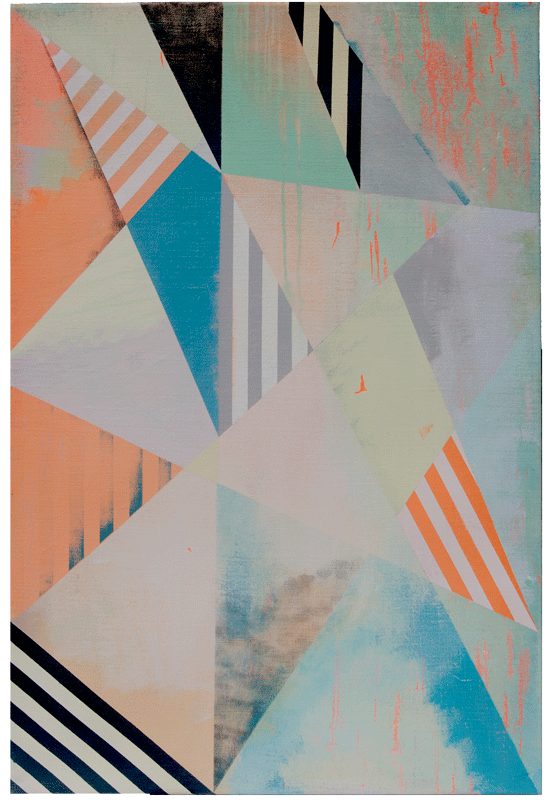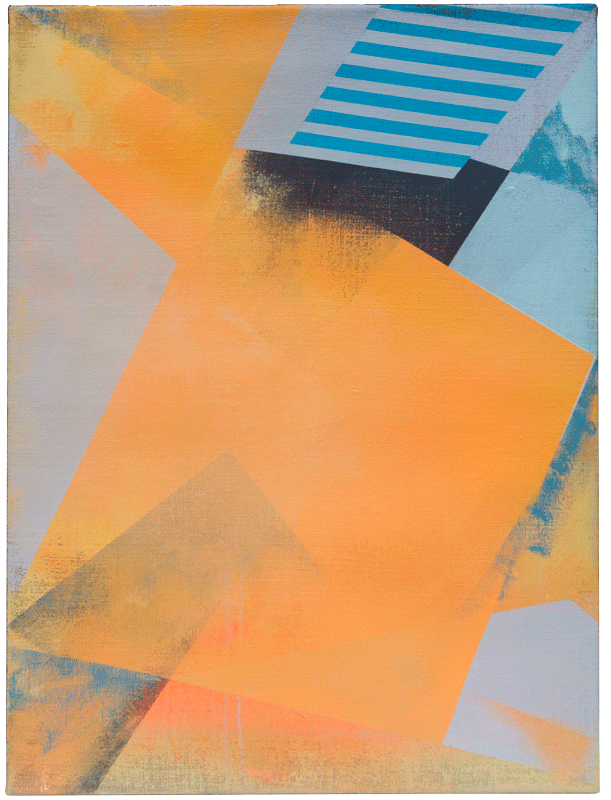Macuto Cannes
2013
The production of this series ran in parallel to other paintings, but it represents a short-lived, very fruitful seed for later works in the development of Gili’s oeuvre.
The starting point is an anecdote written in Federico Vegas’ book Los Incurables. Right in the middle of the book, Armando Planchart, client of Italian Architect Gió Ponti, and friend and patron of painter Armando Reverón, introduces the former to the latter. Gió Ponti was in the country, building the house commissioned by the Planchart family. The house, as Vegas says, “represents the idea that a European architect from the fifties had of how life should be lived in the tropics”. In contrast, Armando Reverón had already built his house, El Castillete, with his own hands and to his own design, using whatever materials were at hand. In complete opposition, his house represents what a local artists thinks of how artists should live in the tropics.
The day Mr. Planchart took Ponti to Macuto to meet Reverón, the latter was already spending time in the mental hospital where he would later die. Nonetheless, Gió Ponti was allowed to enter the house, and it was a revelation to him. The day these two important figures from Venezuelan art almost met is the inspiration for these series of works. Their conceptual meeting is taken to a further level by trying to accomplish the meeting in the medium of painting.
Excerpts from a text published at the Architecture Association Cluster www.saturatedspace.org in 2013: “At the same time as Gió Ponti was coming to Caracas to build his first private commission in the country – a house called Villa Planchart or El Cerrito – Armando Reverón was at the end of his productive career, leaving his self-built, basic ensemble of stone and cane structures – called El Castillete – to enter the mental asylum where he would see his final days.
Armando Reverón is the first modern Venezuelan painter, modern in an unusually isolated way. A painter who went to Madrid – and not to Paris as it was customary to do then – to study painting. In 1915 he returned to Venezuela and a few years later, when he was in his early thirties, settled in Macuto, a small seaside town near the main port of La Guaira, not far from the Capital. He built El Castillete in this rural part of the coast in the belief that artists should live in the same way as they created. His life became simple and self-sufficient and so did his painting. He reduced his tools to the bare minimum and colour became almost an accessory.
Picture surface, because of the resulting roughness, became of extreme importance. His so-called white period (1925-1933), mostly uses recycled jute from carrying sacks from the port, and has only accents of tones other than white: charcoal, dirt, and the raw colour of jute are the main players, and yet it is pure light what comes across in those paintings. He is perhaps the first artist to paint the coastal light from the tropics as a blinding excess. That is the most remarkable feature of his painting as presented in his MoMA show in 2007, but the origins of this are intuitive rather than learnt. Reverón, who before moving back to Venezuela painted some beautiful night paintings as well, is an example of an artist who was more interested in extremes, where vision becomes more difficult, rather than in well-defined edges of the ‘Modernista’ Barcelona or the experimental, silvery influence of the French impressionists, both contemporary to him. The Venezuelan Caribbean coast was an extreme since it was a place with far too much light.
The Plancharts, who would commission Gió Ponti’s masterpiece house, El Cerrito or Villa Planchart were good friends of Armando Reverón, and crucially the ones who would take care of his health. On one of his stays, Ponti was invited by Armando Planchart to visit Reverón´s house on the coast. A famous plan of the site was published in Domus Magazine in 1954, illustrating an article on Reverón written by Ponti himself.
Ponti was fascinated by the house of the Madman of Macuto as a local ideal of what locals build in the tropics, whereas his Villa Planchart is probably the best example of a foreign ideal. Ponti would later write, fascinated by the climate, that “…In the happiness of the tropics modern architecture will flourish under perfect conditions. In other places, architecture is a complicated refuge, a shelter over the terrain. Here, architecture is a wing under which to live in paradise”. In Villa Planchart, the commissioning couple would let Ponti do as he wished. He furnished the house almost entirely with his choice of objects, which included many of his own designs.The house also had to accommodate the growing collection of art and orchids owned by the couple, all of which are still there today and form part of the foundation directed by their sons and daughters. From the striped ceilings hang Calder’s mobiles, and on the walls, works by Reverón, Soto, Otero, Vasarely and Cruz Diez.
It is a common idea even today that colour and light in the surroundings of the artists are major influences in painting. Now as then artists are often asked where colour comes from, as if they had to respond to a place and not to an idea. In a late interview, perhaps bored by the question, Soto differentiates the Parisian impressionist ‘silver light’ from the tropical light that he cannot or does not describe. Somehow for European painting the surroundings influence colour but he does not believe that the tropics, and especially Reverón, saw anything special in the tropical light. Soto goes on to say that the “blinding light of the tropics” may not be actually blinding anyway, it was simply the case that Reverón had it inside himself to paint like that, and would have done so anywhere. Yet in the same interview Soto speaks of the ‘silver light’ from the Paris area as the sole cause that for Impressionism.










